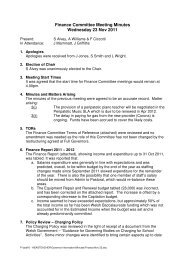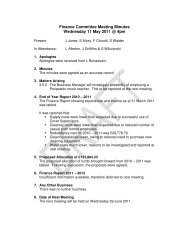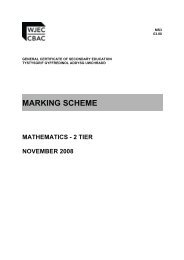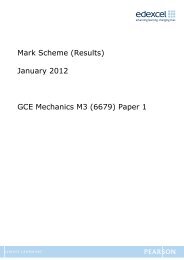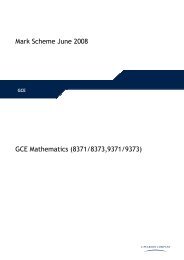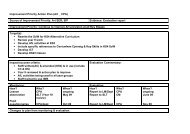Mark Scheme (Results) Summer 2007 - Edexcel
Mark Scheme (Results) Summer 2007 - Edexcel
Mark Scheme (Results) Summer 2007 - Edexcel
You also want an ePaper? Increase the reach of your titles
YUMPU automatically turns print PDFs into web optimized ePapers that Google loves.
<strong>Mark</strong> <strong>Scheme</strong> (<strong>Results</strong>)<br />
<strong>Summer</strong> <strong>2007</strong><br />
GCE<br />
GCE Mathematics<br />
Further Pure Mathematics FP1 (6674)<br />
<strong>Edexcel</strong> Limited. Registered in England and Wales No. 4496750<br />
Registered Office: One90 High Holborn, London WC1V 7BH
June <strong>2007</strong><br />
6674 Further Pure Mathematics FP1<br />
<strong>Mark</strong> <strong>Scheme</strong><br />
Question <strong>Scheme</strong> <strong>Mark</strong>s<br />
number<br />
1.<br />
1<br />
1 and 3 are ‘critical values’, e.g. used in solution, or both seen as asymptotes B1<br />
2<br />
( x + 1)( x − 3) = 2x<br />
− 3 ⇒ x(<br />
x − 4) = 0<br />
x = 4, x = 0 M1: attempt to find at least one other critical value M1 A1, A1<br />
1<br />
1<br />
0 < x < 1 , 3 < x < 4 M1: An inequality using 1 or 3 M1 A1, A1 (7)<br />
2<br />
2<br />
First M mark can be implied by the two correct values, but otherwise a method<br />
must be seen. (The method may be graphical, but either (x = ) 4 or (x =) 0 needs<br />
to be clearly written or used in this case).<br />
Ignore ‘extra values’ which might arise through ‘squaring both sides’ methods.<br />
≤ appearing: maximum one A mark penalty (final mark).<br />
7
Question <strong>Scheme</strong> <strong>Mark</strong>s<br />
number<br />
2. Integrating factor<br />
∫<br />
−tan<br />
x dx<br />
ln(cos x)<br />
−ln(sec<br />
x)<br />
⎛ ⎞<br />
( ) ⎟<br />
⎠<br />
e<br />
⎛ dy<br />
⎜cos<br />
x − y sin x =<br />
⎝ dx<br />
∫<br />
y cos x = 2sec x dx<br />
y cos x = 2 tan x ( + C)<br />
2<br />
2sec<br />
= e<br />
⎞<br />
x⎟<br />
⎠<br />
(or equiv.)<br />
or<br />
e<br />
,<br />
= cos x ⎜or<br />
⎝<br />
2 ⎛<br />
⎞<br />
( ) ⎟<br />
⎠<br />
(or equiv.)<br />
1<br />
sec x<br />
M1, A1<br />
d<br />
2<br />
⎜Or : y cos x = 2sec x<br />
M1 A1(ft)<br />
⎝ dx<br />
y = 3 at x = 0: C = 3 M1<br />
2 tan x + 3<br />
y = (Or equiv. in the form y = f(x)) A1 (7)<br />
cos x<br />
1 st tan d ln(cos ) ln(sec )<br />
M: Also scored for e<br />
∫<br />
x x − x<br />
x<br />
= e ( or e )<br />
, then A0 for sec x .<br />
2 nd M: Attempt to use their integrating factor (requires one side of the equation<br />
‘correct’ for their integrating factor).<br />
2 nd A: The follow-through is allowed only in the case where the integrating<br />
=<br />
4<br />
factor used is sec x or − sec x .<br />
⎛<br />
y sec x 2sec x dx<br />
⎞<br />
⎜<br />
∫<br />
⎟<br />
⎝ ⎠<br />
3 rd M: Using y = 3 at x = 0 to find a value for C (dependent on an integration<br />
attempt, however poor, on the RHS).<br />
Alternative<br />
1 st M: Multiply through the given equation by cos x .<br />
1 st dy<br />
2<br />
A: Achieving cos x − y sin x = 2sec x . (Allowing the possibility of<br />
dx<br />
integrating by inspection).<br />
A1<br />
7
Question <strong>Scheme</strong> <strong>Mark</strong>s<br />
number<br />
3<br />
3<br />
2<br />
3. (a) ( r + 1) = r + 3r<br />
+ 3r<br />
+ 1 and ( r −1)<br />
= r − 3r<br />
+ 3r<br />
−1<br />
M1<br />
3<br />
3<br />
2<br />
3<br />
( r + 1) − ( r −1)<br />
= 6r<br />
3<br />
2<br />
+ 2<br />
(*) A1cso (2)<br />
3<br />
(b) r = 1: 2 − 0 = 6(1 ) + 2<br />
3<br />
3<br />
3<br />
2<br />
2<br />
r = 2 : 3 −1<br />
= 6(2 ) + 2<br />
: : : : : : : : : : :<br />
r = n :<br />
3<br />
3<br />
( n + 1) − ( n −1)<br />
2<br />
= 6n<br />
+ 2 M: Differences: at least first, last M1 A1<br />
and one other.<br />
3 3<br />
2<br />
Sum: ( n + 1) + n −1<br />
= 6∑<br />
r + 2n<br />
M: Attempt to sum at least one side. M1 A1<br />
2 3 2<br />
( 6 ∑ r = 2n<br />
+ 3n<br />
+ n)<br />
n<br />
∑<br />
r=<br />
1<br />
r<br />
2<br />
1<br />
= n(<br />
n + 1)(2n<br />
+ 1)<br />
6<br />
(Intermediate steps are not required) (*) A1cso (5)<br />
2n<br />
2n<br />
n−1<br />
2<br />
2<br />
2 1<br />
1<br />
(c) ∑ r = ∑ r −∑<br />
r , = (2n)(2n<br />
+ 1)(4n<br />
+ 1) − ( n −1)<br />
n(2n<br />
−1)<br />
6<br />
6<br />
r=<br />
n<br />
r=<br />
1<br />
r=<br />
1<br />
2<br />
( 16n<br />
+ 12n<br />
+ 2) − ( 2n<br />
− 3 + 1<br />
1 2<br />
= n n )) M1<br />
6<br />
M1, A1<br />
1<br />
= n ( n + 1)(14n<br />
+ 1)<br />
A1 (4)<br />
6<br />
(b) 1 st A: Requires first, last and one other term correct on both LHS and RHS<br />
(but condone ‘omissions’ if following work is convincing).<br />
2n<br />
∑<br />
∑<br />
∑<br />
(c) 1 st M: Allow also for r = r − r .<br />
r=<br />
n<br />
2<br />
2n<br />
r=<br />
1<br />
2<br />
2 nd 1<br />
M: Taking out (at some stage) factor n , and multiplying out brackets to<br />
6<br />
reach an expression involving terms.<br />
n<br />
r=<br />
1<br />
2<br />
n<br />
2<br />
11
20<br />
10<br />
−2 −1 1 2<br />
−10<br />
−20<br />
y<br />
x<br />
3<br />
Question <strong>Scheme</strong> <strong>Mark</strong>s<br />
number<br />
4. (a) f ′(<br />
x ) = 3x<br />
2 + 8 3x 2 + 8 = 0.......<br />
or 3x<br />
2 + 8 > 0.......<br />
M1<br />
Correct derivative and, e.g., ‘no turning points’ or ‘increasing function’. A1<br />
Simple sketch, (increasing, crossing positive x-axis) B1 (3)<br />
(or, if the M1 A1 has been scored, a reason such as ‘crosses<br />
x-axis only once’).<br />
(b) Calculate f (1) and f (2)<br />
( Values must be seen) M1<br />
f (1) = −10,<br />
f (2) = 5 , Sign change, ∴Root A1 (2)<br />
f (2)<br />
5<br />
(c) x 1 = 2 − ,<br />
= 2 − ( = 1. 75) M1, A1<br />
f ′(2)<br />
20<br />
f ( x1)<br />
⎛ 0.359375 ⎞<br />
x<br />
2<br />
= x1<br />
− ,<br />
⎜=<br />
1.75 − ⎟ = 1.729 (ONLY) (α) M1, A1 (4)<br />
f ′(<br />
x )<br />
⎝ 17.1875 ⎠<br />
1<br />
(d) Calculate f ( α − 0.0005)<br />
and f ( α + 0.0005)<br />
M1<br />
(or a ‘tighter’ interval that gives a sign change).<br />
f (1.7285) = −0.0077...<br />
and f (1.7295) = 0.0092...<br />
, ∴Accurate to 3 d.p. A1 (2)<br />
11<br />
(a) M: Differentiate and consider sign of f ′(<br />
x)<br />
, or equate f ′(<br />
x)<br />
to zero.<br />
Alternative:<br />
3<br />
3<br />
M1: Attempt to rearrange as x −19<br />
= −8x<br />
or x = 19 − 8x<br />
(condone sign slips),<br />
and to sketch a cubic graph and a straight line graph.<br />
A1: Correct graphs (shape correct and intercepts ‘in the right place’).<br />
B1: Comment such as “one intersection, therefore one root”).<br />
(c) 1st A1 can be implied by an answer of 1.729, provided N.R. has been used.<br />
Answer only: No marks. The Newton-Raphson method must be seen.<br />
(d) For A1, correct values of f(1.7285) and f(1.7295) must be seen, together with a<br />
conclusion. If only 1 s.f. is given in the values, allow rounded (e.g. − 0.008)<br />
or truncated (e.g. − 0.007 ) values.
Question <strong>Scheme</strong> <strong>Mark</strong>s<br />
number<br />
2<br />
5. C.F. m + 3m<br />
+ 2 = 0 m = −1<br />
and m = −2<br />
M1<br />
y =<br />
Ae<br />
− x<br />
+ Be<br />
−2x<br />
A1 (2)<br />
P.I.<br />
2<br />
y = cx + dx + e<br />
B1<br />
d 2<br />
2<br />
y<br />
d y<br />
2<br />
= 2cx<br />
+ d,<br />
= 2c<br />
2c<br />
+ 3(2cx<br />
+ d)<br />
+ 2( cx + dx + e)<br />
≡ 2x<br />
+ 6x<br />
M1<br />
2<br />
dx<br />
dx<br />
2 c = 2<br />
c = 1<br />
(One correct value) A1<br />
6 c + 2d<br />
= 6<br />
d = 0<br />
2c + 3d<br />
+ 2e<br />
= 0<br />
e = −1<br />
(Other two correct values) A1<br />
− x<br />
−2x<br />
2<br />
General soln: y = Ae<br />
+ Be<br />
+ x −1<br />
(Their C.F. + their P.I.) A1ft (5)<br />
( A + 2)<br />
x = 0 , y = 1: 1 = A + B −1<br />
B =<br />
M1<br />
d −x<br />
− 2 x<br />
y<br />
= −Ae<br />
dx<br />
− 2Be<br />
dy<br />
+ 2x,<br />
x = 0, = 1:<br />
1 = −A<br />
− 2B<br />
M1<br />
dx<br />
Solving simultaneously: A = 5 and B = −3<br />
M1 A1<br />
− x<br />
−2x<br />
2<br />
Solution: y = 5e − 3e + x −1<br />
A1 (5)<br />
1 st M: Attempt to solve auxiliary equation.<br />
12<br />
2 nd 2<br />
dy<br />
d y<br />
M: Substitute their and<br />
2 into the D.E. to form an identity in x with<br />
dx<br />
dx<br />
unknown constants. .<br />
3 rd M: Using y = 1 at x = 0 in their general solution to find an equation in A and B.<br />
4 th M: Differentiating their general solution (condone ‘slips’, but the powers of<br />
d y<br />
each term must be correct) and using = 1 at x = 0 to find an equation<br />
dx<br />
in A and B.<br />
5 th M: Solving simultaneous equations to find both a value of A and a value of B.
Question <strong>Scheme</strong> <strong>Mark</strong>s<br />
number<br />
*<br />
6. (a) z = 3 + i<br />
B1<br />
z<br />
z<br />
*<br />
=<br />
( 3 − i)( 3 − i)<br />
( 3 + i)( 3 − i)<br />
3 − 2 3i −1<br />
=<br />
,<br />
3 + 1<br />
2<br />
z ⎛ 1 ⎞ ⎛ ± 3 ⎞<br />
(b) = ⎜ ⎟ , = 1<br />
*<br />
⎜ ⎟ +<br />
z ⎝ 2 ⎠<br />
2<br />
⎝ ⎠<br />
2<br />
=<br />
1<br />
2<br />
−<br />
3<br />
2<br />
⎡<br />
⎢Or<br />
:<br />
⎢<br />
⎣<br />
i<br />
z<br />
*<br />
z<br />
z 3 + 1 ⎤<br />
= = , = 1⎥<br />
*<br />
z 3 + 1 ⎥<br />
⎦<br />
(c) arg ( w ) = arctan⎜<br />
real( w)<br />
⎟ or arg ( ) = arctan⎜<br />
⎠<br />
imag( w)<br />
⎟ ⎠<br />
(*) M1, A1cso (3)<br />
M1, A1 (2)<br />
⎛ imag ( w)<br />
⎞<br />
⎜ ±<br />
w<br />
⎛<br />
⎜ ±<br />
real ( w)<br />
⎞<br />
, M1<br />
⎝<br />
⎝<br />
where w is z or<br />
* z<br />
z or<br />
*<br />
z<br />
⎛ − 3 ⎞<br />
⎛ z ⎞ ⎜ ⎟<br />
⎜ ⎟ =<br />
2<br />
π<br />
arg arctan⎜<br />
⎟<br />
= −<br />
*<br />
⎝ z ⎠ ⎜<br />
1<br />
⎟<br />
3<br />
⎝ 2 ⎠<br />
A1<br />
⎛ −1<br />
⎞ π<br />
⎛ 1 ⎞ π<br />
*<br />
arctan⎜<br />
⎟ = − and arctan⎜<br />
⎟ = (Ignore interchanged z and z ) A1<br />
⎝ 3 ⎠ 6<br />
⎝ 3 ⎠ 6<br />
* π π π ⎛ z ⎞<br />
arg z − arg z = − − = − = arg⎜<br />
*<br />
⎟<br />
6 6 3 ⎝ z ⎠<br />
A1 (4)<br />
(d)<br />
2 y<br />
1<br />
*<br />
z<br />
z and<br />
*<br />
z<br />
(Correct quadrants, approx. symmetrical) B1<br />
− 1 2 3<br />
−<br />
(e) ( − ( 3 − i<br />
)( x − ( 3 + i<br />
)<br />
−<br />
x<br />
z<br />
*<br />
z z<br />
(Strictly inside the triangle shown here) B1 (2)<br />
x M1<br />
⎛ − b ⎞<br />
⎞<br />
Or: Use sum of roots ⎜= ⎟ and product of roots ⎜<br />
⎟ ⎝ a ⎠ ⎝ ⎠<br />
2<br />
x − 2 3x + 4<br />
A1 (2)<br />
13<br />
(a) M: Multiplying both numerator and denominator by 3 − i , and multiplying<br />
out brackets with some use of i 2 = −1.<br />
(b) Answer 1 with no working scores both marks.<br />
(c) Allow work in degrees: −60°, −30° and 30°<br />
5π 11π π<br />
Allow arg between 0 and 2π : , and (or 300°, 330° and 30°).<br />
3 6 6<br />
Decimals: Allow marks for awrt −1.05 (A1), −0.524 and 0.524 (A1), but then<br />
A0 for final mark. (Similarly for 5.24 (A1), 5.76 and 0.524 (A1)).<br />
(d) Condone wrong labelling (or lack of labelling), if the intention is clear.
6<br />
4<br />
2<br />
Question <strong>Scheme</strong> <strong>Mark</strong>s<br />
number<br />
7. (a) 5<br />
(b)<br />
2 4 6<br />
Shape (closed curve, approx. symmetrical about<br />
the initial line, in all ‘quadrants’ and<br />
x<br />
−4<br />
5 − √3 5 + √3 ‘centred’ to the right of the pole/origin). B1<br />
−2<br />
5 Scale (at least one correct ‘intercept’ r value…<br />
−6<br />
shown on sketch or perhaps seen in a table). B1 (2)<br />
(Also allow awrt 3.27 or awrt 6.73).<br />
y = r sinθ<br />
= 5sinθ<br />
+ √ 3sinθ<br />
cosθ<br />
M1<br />
d y<br />
2<br />
= 5cosθ<br />
− √ 3sin θ + √ 3cos<br />
θ<br />
dθ<br />
( = 5cosθ<br />
+ √ 3cos 2θ<br />
)<br />
A1<br />
2<br />
2<br />
5cosθ − √ 31−<br />
cos θ + √ 3cos θ =<br />
M1<br />
2<br />
−2<br />
−4<br />
y<br />
( ) 0<br />
2√<br />
3cos θ + 5cosθ<br />
− √ 3 = 0<br />
2 √ 3cosθ<br />
−1<br />
cosθ<br />
+ √ 3 = 0 cosθ<br />
=<br />
( )( ) ...<br />
(0.288…)<br />
⎛<br />
1 ⎞<br />
θ = 1.28 and 5.01 (awrt) (Allow ±1.28 awrt) ⎜Also allow ± arccos ⎟ A1<br />
⎝<br />
2√<br />
3 ⎠<br />
⎛ 1 ⎞ 11<br />
r = 5 + √ 3⎜<br />
⎟ = (Allow awrt 5.50) A1 (6)<br />
⎝ 2√<br />
3 ⎠ 2<br />
2<br />
2<br />
(c) r = 25 + 10√<br />
3cosθ<br />
+ 3cos θ<br />
B1<br />
2 53θ<br />
⎛ sin 2θ<br />
⎞<br />
25 + 10√<br />
3cosθ + 3cos θ dθ<br />
= + 10√<br />
3sinθ<br />
+ 3<br />
∫<br />
⎜ ⎟<br />
M1 A1ft A1ft<br />
2<br />
⎝ 4 ⎠<br />
(ft for integration of ( ) bcosθ<br />
a + and c cos2θ<br />
respectively)<br />
2π<br />
1 ⎡<br />
3sin 2θ<br />
3θ<br />
⎤<br />
25 10 3sin<br />
2 ⎢ θ + √ θ + +<br />
4 2 ⎥<br />
⎣<br />
⎦ 0<br />
= ......<br />
M1<br />
53<br />
= 1 ( 50π + 3π<br />
) =<br />
π or equiv. in terms of π.<br />
2<br />
2<br />
A1 (6)<br />
14<br />
(b) 2 nd M: Forming a quadratic in cos θ .<br />
3 rd M: Solving a 3 term quadratic to find a value of cos θ (even if called θ ).<br />
Special case: Working with r cosθ<br />
instead of r sinθ<br />
:<br />
1 st 2<br />
M1 for r cosθ<br />
= 5cosθ<br />
+ √ 3cos θ<br />
1 st A1 for derivative − 5sinθ<br />
− 2√<br />
3sinθ<br />
cosθ<br />
, then no further marks.<br />
(c) 1 st M: Attempt to integrate at least one term.<br />
2 nd M: Requires use of the 2<br />
1 , correct limits (which could be 0 to 2π, or<br />
−π to π, or ‘double’ 0 to π), and subtraction (which could be implied).<br />
M1





